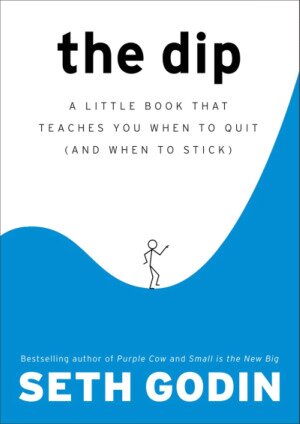Have You Read ‘The Dip’ From Seth Godin?

Some might think this book is irreverent. Others might find The Dip runs counter to their instincts and drives to keep on keeping on – no matter what, and at any cost.
Godin actually brings something new to the self-improvement mash up: know when to quit. It’s a message worthy of a read for those who take risks, walk uncharted roads and lead the way.
Sometimes, you just have to know when to throw in the towel.
So, a quick look at the main points etched in stone by Seth Godin in The Dip:
1. Quitters never prosper: WRONG
Seth puts forth an interesting hypothesis – one based on common sense. Quitters DO prosper. In fact, quitters are the innovators of the world. They take chances. They do things no one has ever done before.
However, these leaders from all fields of endeavor are almost certain to execute projects that don’t succeed. The key, according to Seth, is to know when to quit and move on to the next item from the long list of adventures undertaken by the daring, far-sighted visionary.
Wosniack and Jobs created the concept and prototype of personal computing in a garage, working with a piggy bank-sized budget. There success was evolutionary. Failures in design, the lack of a user-friendly interface and primitive technology limited the growth of Apple in the early days.
However, the successes far outweighed the failures and today, in retrospect, these two innovators changed world history using parts from a local Radio Shack. Godin would agree that Woz and Jobs did it right. They moved forward based on a measurement of success – not on a lost cause based solely on hope. They saw the impact the first Apple computer had – and when the Apple IIe came along in 1982, the company took off like a rocket, and geeks were learning DOS code to implement the simplest tasks.
2. Every project has an arc.
When innovators first undertake a new project, according to Godin, things start out “exciting and fun.” As the heavy lifting continues, the project becomes more and more like work, i.e. it’s not much fun anymore. (Most of us have experienced this part of the project arc many times – each time we take on a new client.)
The second part of the project arc is an in-depth analysis of whether the desired outcomes are worth “the hassle.” Well, when you’ve committed to a client you have a professional obligation to complete the project – but, if it isn’t worth the hassle, there’s nothing that says you have to collaborate a second or third time.
According to Godin, “Maybe you’re in a Dip – a temporary setback that will get better if you keep pushing. But maybe it’s a cul-de-sac, which will never get better, no matter how hard you try.”
You, the innovator, the renegade, the freelancer who follows his own course, is the only one who can decide whether a project, vision or dream is worth the hassle. If it isn’t, it’s a good time to quit, closing out that project arc.
3. Know When to Quit
You know yourself better than anyone. You know your strengths and limitations, what is and is NOT acceptable in life. This is true of anyone who opts for the “road less taken” – Robert Frost.
Well, based on those personality traits, you should be able to step back and examine the current venture from an impartial POV to determine if the headaches and hassles are worth the pursuit of your desired outcomes.
Some of us have endless patience. Others, the attention span of a three-year-old on a sugar high. You know your tolerances. You know your personal and professional limits and limitations.
According to The Dip, the smart innovator evaluates her circumstances to arrive at a conclusion based on rational analysis, not pure emotion. The innovator knows when to call it quits and move on.
4. Learn from your mistakes.
I think this is the bottomline takeaway of The Dip.
Innovators make mistakes. Smart innovators learn from those mistakes and apply those lessons to the next undertaking. In fact, IMHO, we learn our best lessons from our worst mistakes. I think Seth would agree with me.
Quitting isn’t a bad thing. It’s not a sign of weakness – it’s actually the astute thing to do in many cases. Know when to quit.
Finally, pick up a copy of The Dip by Seth Godin, or visit the author’s blog.
You’ll never again be afraid to crash and burn. Like the phoenix, the innovators of the world and of the web will rise from the ashes to pursue another avenue to success.



One of the big secrets to success is knowing when to quit and when to stick.
12333
Hi, Edward,
Thanks for the tip. I’ll add it to my reading list. Seems I always stick around longer than I should with a lot of the projects I take on from clients.
It’s a guilt thing, I think. But also, freelancers are always reluctant to turn down work – even if they know the project is doomed to fail. It’s my job to tell clients that their vision won’t fly. Once I’ve done that, and the client wants to continue, I sleep soundly without guilt. It’s not my job to tell clients they’re heading down a dead-end road time after time, so I help the client as much as possible.
Sometimes I’m pleasantly surprised and the project actually hits objectives, but most of the time it’s a lost cause.
Thanks for the post,
Paulie
hallo good morrning